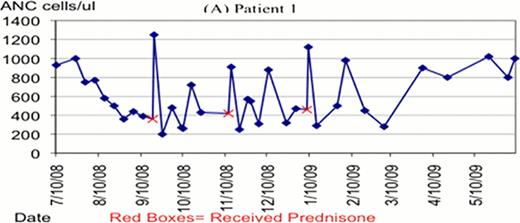Abstract
Abstract 4942
The mechanism of lenalidomide-induced neutropenia, a common reason for cessation of therapy, has recently been shown to involve down-regulation of transcription factor PU. 1, resulting in granulocyte maturation arrest and accumulation of myeloid precursors (Pal S, et al. Blood 2010; 115(3):605–614). Data have also exhibited a correlation between cytopenias and response to therapy in del(5q) patients alone, revealing lenalidomide-induced neutropenia or thrombocytopenia as a predictor of transfusion independence (Sekeres MA, et al. J Clin Oncol 2008. 26(36):5943–5949). Because preliminary data from our phase I/II optimal dose study in non-5q- low and int-1 risk patients has shown a lower degree of both neutropenia and thrombocytopenia than that observed in patients treated with the same 10mg/d dose for del(5q) disease, we hypothesized that the comparably poor response of non-del(5q) patients may be related to the lesser degree of associated cytopenias in the setting of a suboptimal dose. Anticipating the limitation of optimal dosing by neutropenias, we set out to determine whether we could avoid withholding the drug for safety by demonstrating the patients' ability to mobilize neutrophils with corticosteroid administration, in contrast to limitation by true marrow suppression.
In the course of our phase I/II optimal dose study, we examined whether cytopenias observed with high dose lenalidomide may be attributed to margination rather than entirely to true marrow suppression. Eight patients with low or int-1 risk non-del(5q) MDS received lenalidomide at an increased dose of 15mg to 20mg, administered for 21d of each 28d cycle. A baseline absolute neutrophil count along with a pre-therapy response of peripheral granulocytes to prednisone was established. Patients whose absolute neutrophil count decreased during therapy to less than 50 percent of the pre-study baseline underwent a granulocyte mobilization test, receiving a 1mg/kg dose of prednisone with a complete blood count drawn both before and twenty four hours after administration to assess change in absolute neutrophil count. In patients with a positive steroid test, we proceeded with therapy. In those with a negative steroid test, lenalidomide was held until recovery of ANC. This study is listed on clinicaltrials. gov under the identifier NCT00699842.
Of the 8 patients enrolled in the study, 4 (50%) of these patients developed neutropenia with an absolute neutrophil count (ANC) falling to less than 50% of their pre-treatment baseline. Of these patients, 2 had a marked response to the prednisone granulocyte mobilization test, with 24-hour post-steroid ANC levels approaching and in most cases exceeding the patients' baseline values (Fig. 1). A third patient had a less notable and delayed response, but did exhibit an increase in ANC from less than 50% to within 5% of pre-study baseline. The fourth patient responded minimally and was taken off of the study to receive G-CSF (Fig. 3).
Patient 1 received steroid test (Prednisone 1 mg/kg) with good response of mobilizing ANC 24 hours after dose. Also tolerated higher lenalidomide dose without stopping with positive steroid response.
Patient 1 received steroid test (Prednisone 1 mg/kg) with good response of mobilizing ANC 24 hours after dose. Also tolerated higher lenalidomide dose without stopping with positive steroid response.
Patient 2 had an adequate ANC which never fell below 500, and was continued on lenalidomide without a granulocyte mobilization test.
Patient 2 had an adequate ANC which never fell below 500, and was continued on lenalidomide without a granulocyte mobilization test.
Patient 3 had low baseline ANC (<500) with no response to steroid testing and lenalidomide was discontinued on 2/1/09, indicating true myelosuppression as the cause of the neutropenia.
Patient 3 had low baseline ANC (<500) with no response to steroid testing and lenalidomide was discontinued on 2/1/09, indicating true myelosuppression as the cause of the neutropenia.
There was no increase in neutropenic fever during the course of the study, although the observation was limited to only 8 patients.
Determining increments of ANC (31000) following steroid administration in 3 (75%) of the studied patients who developed marked neutropenia in the setting of an elevated dose of lenalidomide demonstrated a return of the absolute neutrophil count to pre-treatment levels. The drug was continued on these patients with no neutropenic fever nor other adverse event. The results of the study provide evidence that margination of neutrophils is a contributing mechanism of lenalidomide-induced neutropenia, providing an alternative explanation to true marrow suppression as the primary etiology of observed cytopenias. This may allow for increased tolerance and determination of the optimal dose of lenalidomide in the treatment of patients with non-5q myelodysplastic syndrome.
Besa:Celgene: Research Funding. Quan:Celgene: Employment.
Author notes
Asterisk with author names denotes non-ASH members.




